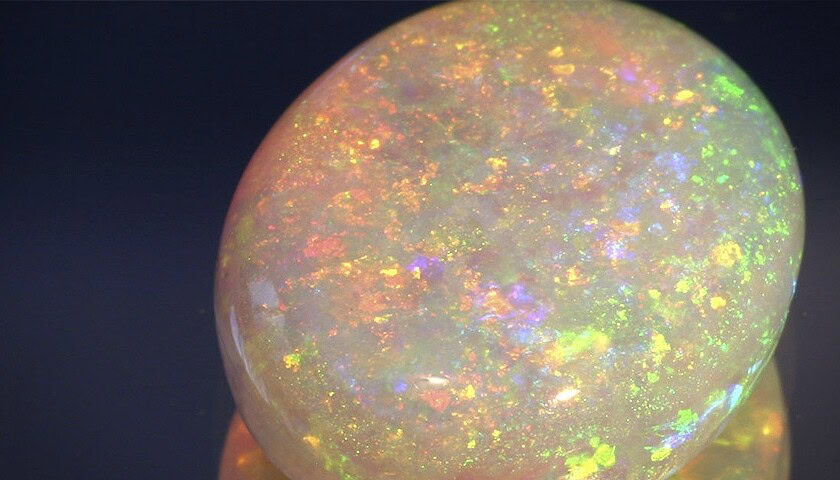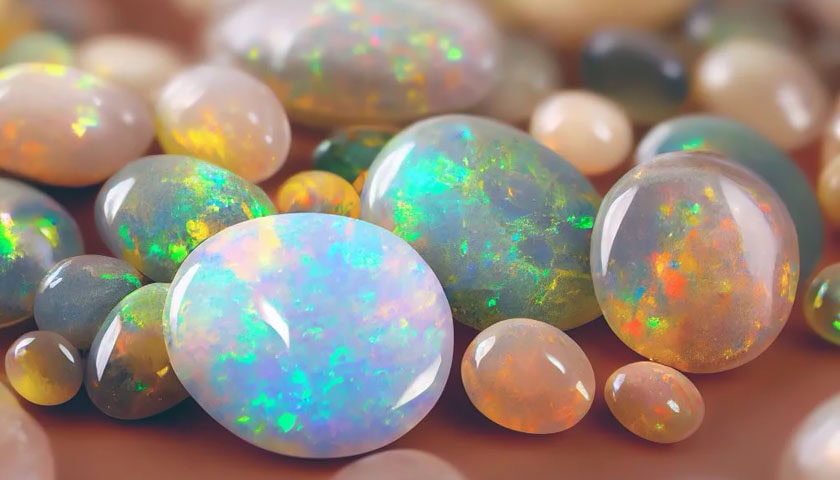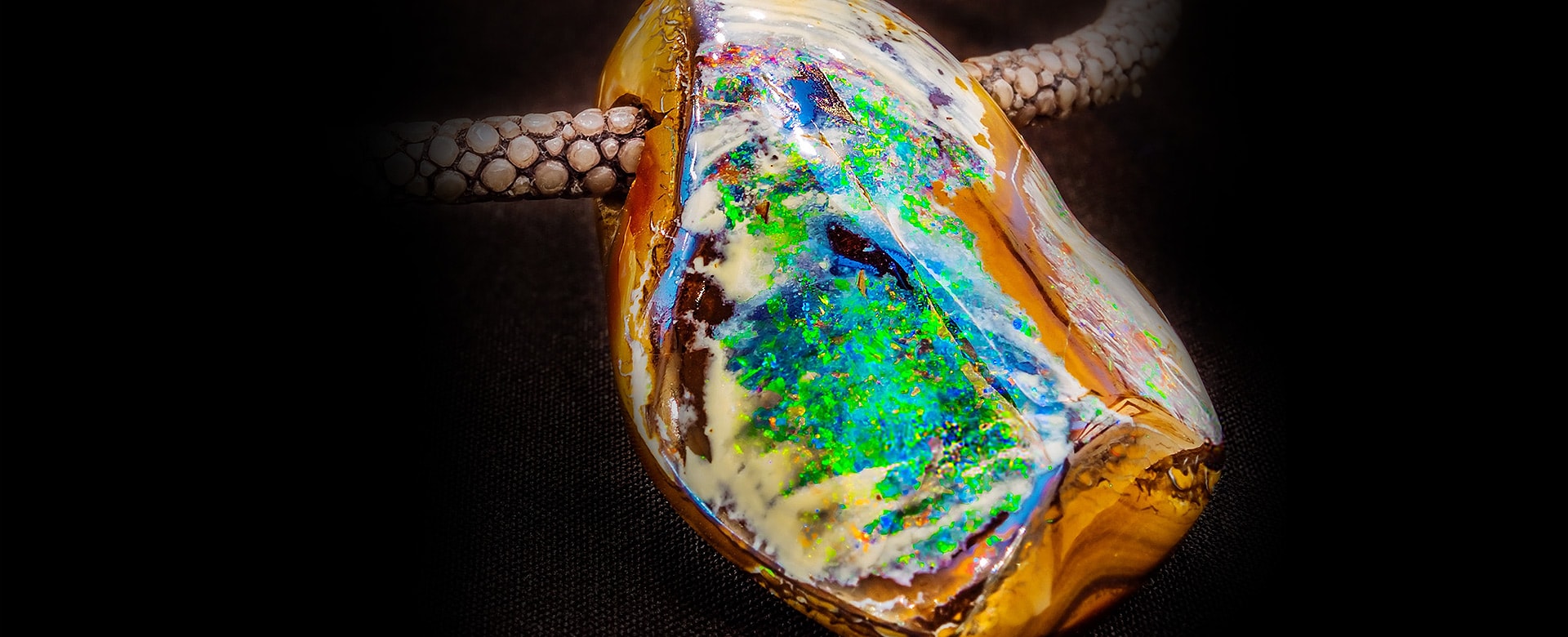Article Highlights
Ethiopian Opal has been a favorite among gem sellers and gem lovers for years. This is perhaps due to its rarity and ridiculously lower prices than Australian opals and other select gemstones. Such a dilemma has prompted the stone’s success as people seek to understand why it is rare and equally cheap. Below is an in-depth guide on Ethiopian opals.
Ethiopian Opal History

Ethiopian Opal was first discovered in 1990 and first mined commercially in 2008. The stone’s origin is Ethiopia’s northern Welo District. This mining area also has several opal choices, including those found in Australia’s opal mines.
Before the discovery of Ethiopian opal, archaeology showed that opals played a huge part in East African trade as early as 4000 BC. Moreover, Louis Leakey’s discovery in 1939 shed light on the fact that opals had been in the hands of people in Kenya for almost 6,000 years before the Ethiopian opal’s discovery.
For the longest time, Australian opal has dominated the opal industry, generally setting the standards for opal trading. However, some gem experts believe that Ethiopian opal may soon overtake the Australian opal with relatively steady growth. Such is owed to the gem’s lower prices, unique beauty, and availability in flashy and hydrophane varieties.
Ethiopian Opal Geological Properties

Generally, opals are sedimentary by default. This means that the opals are created from the layers of ancient waterways. However, Ethiopian opals are also classified as hydrophane opals. These opal types are formed due to volcanic activity. In addition, they form in nodules within the volcanic ash between rhyolite layers in the stratum.
| Category | Mineraloid |
| Formula (repeating unit) | Hydrated silica. SiO2·nH2O |
| Crystal system | Amorphous |
| Crystal habit | Irregular veins, in masses, in nodules |
| Fracture | Conchoidal to uneven |
| Mohs scale hardness | 5.5 – 6 |
| Luster | Subvitreous to waxy |
| Diaphaneity | opaque, translucent, transparent |
| Specific gravity | 2.15+0.08 |
| −0.90 | |
| Density | 2.09 g/cm3 |
| Polish luster | Vitreous to resinous |
| Optical properties | Single refractive, often anomalous double refractive due to strain |
| Refractive index | 1.450+0.020 |
| −0.080 | |
| Absorption spectra | green stones: 660 nm, 470 nm cutoff |
| Diagnostic features | darkening upon heating |
| Solubility | hot saltwater, bases, methanol, humic acid, hydrofluoric acid |
“Hydrophane” originates from Greek and translates to “water-loving”. This describes Ethiopian opals’ typical water absorption. Water absorption often changes the Ethiopian opal’s appearance, altering it from semi-translucent or opaque to near transparency or extremely translucent. If removed from the water, Ethiopian opal gets milky, and after a few days, it retains its original appearance and beauty.
Ethiopian opal colors include black, brown, green, orange, red, yellow, white, colorless, blue, to waxy.
Ethiopian Opal Vs. Australian Opal
Australia has been dominating the opal sector for decades prior to the discovery of Ethiopian opal in 1990. Australian opal set the standards and benchmark for opal trade for over 100 years. Unfortunately, despite the significant headstart, Ethiopian opal is soon overtaking Australia in various aspects, including production.
Currently, the quantity of Ethiopian opal found in the market rivals what comes from Australia. In addition, the ease of availability and relative affordability of Ethiopian opals is currently opening up doors for more opal jewelry lovers to engage in the trade.
The main difference between Ethiopian opal and Australian opal is Ethiopian opal’s hydrophane properties. Unlike the Australian opal, Ethiopian opal changes its state in water. Opal experts also believe Ethiopian opal is resistant to crazing and is impressively durable.
Moreover, the Ethiopian opal is the best crystal material and is considered the finest quality due to its high transparency. Such high transparency levels allow to cab or facet carve the Ethiopian opal with little effort.
Unlike Australian opals, Ethiopian opals also come in varying shapes and colors. They are also generally larger than Australian opals, yet still cheaper. Regardless, most opal enthusiasts still prefer the Australian alternatives for varying personal reasons.
Ethiopian Opal Healing Properties and Benefits

The word “opal” originates from the Greek word “opallios”, meaning to see a change of color. This meaning is connected to how precious opals refract light. Since its discovery, Ethiopian opal has been used in several healing aspects, including physical, emotional, and spiritual healing.
Physical Healing
The stone grants extraordinary user foresight. Ethiopian opal favors the user’s skin, nails, hair, and eye health. Moreover, Ethiopian opal helps to purify the user’s blood and kidneys. It also regulates insulin production.
Ethiopian opal is believed to protect the user from the evil’s eye. The stone also enhances sexual libido and lifts sensuality. In addition, it strengthens visual acuity while also healing ear complications. Ethiopian opal helps to alleviate any problems related to the heart, lungs, and liver.
Moreover, the stone has laxative and sedative effects. It also minimizes the effects of poison and acidity. It helps to ponder your body’s water content and assists with challenges such as less water retention or hydration.
The stone also helps in slimming down fevers. It revives your memory and steadies out your neurotransmitter issues. Finally, the Ethiopian opal helps with issues related to female hormones and provides immense comfort during childbirth. Generally, it is a favorite for people dwelling around water bodies due to its hydrophane properties.
Emotional Healing
Ethiopian opal provides users an overwhelming sense of calm. This, in turn, encourages honesty, faith, truth, purity, and loyalty. In addition, the stone is dedicated to providing strength and healing to one’s emotional existence. It pushes and encourages users to be honest with themselves at all times.
The stone has potent internal energy that draws all emotions to the surface level, allowing you to handle the situation with a clearer, decisive mind. It also helps users get rid of negative emotions and soothes their sadness. This then makes the user feel more in control and unruffled.
Besides, Ethiopian opal stimulates one’s confidence, positivity, and ability to love. Over time, the stone has been considered a jewel of happy changes. This is because it evokes joy from the understanding that the user has unlimited potential to meet their future aspirations.
The stone comes in varying beautiful colors, each carrying an important symbolism. The white Ethiopian opal symbolizes freedom, green stands for cheerfulness, yellow stands for abundant wealth, and brown is intended to bring wisdom.
In addition, Ethiopian opal helps women tap into their soul goddess, allowing them to reach peak femininity. The stone does not leave anything to chance for the modern woman seeking to tap into its beauty and elegance.
For years, the stone has been linked to the matrix of life. The stone possesses a notable tendency to inspire wisdom. It also tends to reinforce and allow the growth of love due to its unwavering magnetic potency. Most importantly, the gemstone helps the user to learn to love and appreciate themselves more by reminding them that all surrounding things are true and good.
Spiritual Healing
The Ethiopian opal is a reliable and effective gemstone for welcoming spiritual light into the aura. Moreover, it opens up your mind to fresh hopes and wishes. It also awakens the mystical and psychic qualities of the stone’s user.
The stone enhances the user’s cosmic awareness, thus increasing their level of insight and intuition. It also augments lucid dreaming and has been used to invoke apparitions. It has protective advantages and is used by people venturing deep into the journey of self-healing.
The stone is believed to be linked to Mercury and Hermes, the Greek god. It is a jewel of light and attracts angelic energies to allow for easier communication with the heavens. In addition, the Ethiopian opal is also a water stone possessing the perfect vibration to connect with water spirits.
It also grants intuitive recognition, allowing you to easily absorb what the cosmos demands and not what it requires. The stone helps to fight materialism and also solidifies religious beliefs. It has found great use and reverence among monks, hermits, and different people seeking spiritual nourishment.
Ethiopian Opal and Chakra

Ethiopian comes in many colors. However, its dominant colors have been deployed to represent and excite the chakras. The white Ethiopian opal energy activates the Crown Chakra, the epicenter of spirituality that allows wearers to interact with divinity. The white energy offers peace and wisdom and binds the user to the source of universal force. In addition, it transforms and eliminates negative energies while stabilizing your aura. Moreover, it may also turn on the Third Eye Chakra, which dispels negative energy and controls your body’s energy flow.
The opal’s pink and green energies inspire the Heart Chakra, which facilitates users to moderate the interactions with the external existence. It also helps users embrace their resistance gladly and is perfect for maintaining healthy relationships and interactions.
The opal’s red and brown energies inspire the Base Chakra, perfect for balancing kinaesthetic movement energy. In addition, the orange and gold energies inspire the Sacral Chakra.
Price of Ethiopian Opals
The stone’s jewelry is surprisingly very affordable, unlike its Australian competition. However, the value of Ethiopian opal is expected to increase significantly since Australian mines may soon be depleted of this rare stone.
Different factors influence the prices of Ethiopian opal, for example, the presence of color flashes and the number of colors displayed. The most valuable stones have transparent colors, intense color flashes, larger sizes, and are evenly cut. The Honeycomb opal is perhaps an exception to this rule due to its natural pattern that makes it rare and highly valuable.
Generally, the Ethiopian opal’s price per carat ranges from $10-$250 based on the color intensity, patterns, and varieties. The low price of the Ethiopian opal is largely owed to its availability. Since it is a recent discovery, there is a relatively large supply of Ethiopian opals, thus affecting its pricing.
Bottom Line
The Ethiopian opal rival the Australian opal in terms of versatility. It has more color intensities and variations. Surprisingly, it is cheaper than the Australian variety. However, it remains one of the most beautiful and sought-after opal varieties.



